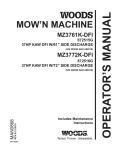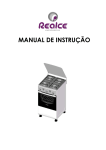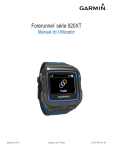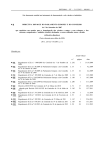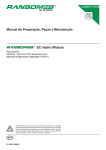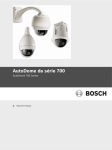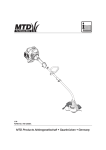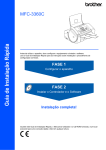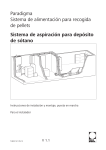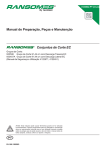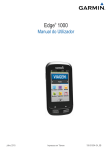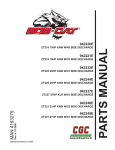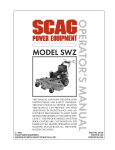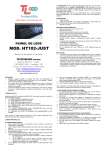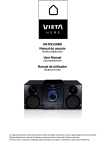Download EC Hydro Midsize
Transcript
36” SIDE DISCHARGE HYDRO MIDSIZE Rev.A 12-2007 MAN 4163233-PT 933304 16HP KAW ES EU Parts Manual 4163232 OPERATOR MANUAL 933303 16HP KAW ES EU OPERADOR MANUAL 36” REAR DISCHARGE HYDRO MIDSIZE EC Hydro Midsize CONTENTS IMPORTANT MESSAGE Thank you for purchasing this CGC Inc. product. You have purchased a world class mowing product, one of the best designed and built anywhere. This machine comes with an Operation and Safety Manual and a separate Setup, Parts and Maintenance Manual. The useful life and good service you receive from this machine depends to a large extent on how well you read and understand these manuals. Treat your machine properly, lubricate and adjust it as instructed, and it will give you many years of reliable service. Your safe use of this CGC Inc. product is one of our prime design objectives. Many safety features are built in, but we also rely on your good sense and care to achieve accident-free operation. For best protection, study the manuals thoroughly. Learn the proper operation of all controls. Observe all safety precautions. Follow all instructions and warnings completely. Do not remove or defeat any safety features. Make sure those who operate this machine are as well informed and careful in its use as you are. See a CGC Inc. dealer for any service or parts needed. CGC Inc. service ensures that you continue to receive the best results possible from CGC Inc.’ products. You can trust CGC Inc. replacement parts because they are manufactured with the same high precision and quality as the original parts. CGC Inc. designs and builds its equipment to serve many years in a safe and productive manner. For longest life, use this machine only as directed in the manuals, keep it in good repair and follow safety warnings and instructions. You'll always be glad you did. Commercial Grounds Care Inc. One Bob Cat Lane Johnson Creek, WI 53038-0469 TABLE OF CONTENTS PAGE CONTENTS ................................................................................................................................................... 1 SAFETY ......................................................................................................................................................... 2 LABELS ....................................................................................................................................................... 3-5 GENERAL INSTRUCTIONS ...................................................................................................................... 6, 7 CONTROLS ............................................................................................................................................... 8, 9 MACHINE OPERATION .......................................................................................................................... 10-12 HEIGHT OF CUT .................................................................................................................................... 13-15 BELT REPLACEMENT ................................................................................................................................. 16 ADJUSTMENTS ...................................................................................................................................... 17-20 VIBRATION LEVEL ...................................................................................................................................... 21 SPECIFICATIONS ................................................................................................................................... 22-24 RANSOMES WARRANTY ..................................................................................................................... 25, 26 9 2007 GB-1 EC Hydro Midsize SAFETY NOTICE !!! Unauthorized modifications may present extreme safety hazards to operators and bystanders and could also result in product damage. Commercial Grounds Care Inc. strongly warns against, rejects and disclaims any modifications, add-on accessories or product alterations that are not designed, developed, tested and approved by Commercial Grounds Care Inc. Engineering Department. Any Commercial Grounds Care Inc. product that is altered, modified or changed in any manner not specifically authorized after original manufacture–including the addition of “after-market” accessories or component parts not specifically approved by Commercial Grounds Care Inc.–will result in the Commercial Grounds Care Inc. Warranty being voided. Any and all liability for personal injury and/or property damage caused by any unauthorized modifications, add-on accessories or products not approved by Commercial Grounds Care Inc. will be considered the responsibility of the individual(s) or company designing and/or making such changes. Commercial Grounds Care Inc. will vigorously pursue full indemnification and costs from any party responsible for such unauthorized post-manufacture modifications and/or accessories should personal injury and/or property damage result. This symbol means: ATTENTION! BECOME ALERT! Your safety and the safety of others is involved. Signal word definitions: The signal words below are used to identify levels of hazard seriousness. These words appear in this manual and on the safety labels attached to Textron Golf, Turf & Specialty Products machines. For your safety and the safety of others, read and follow the information given with these signal words and/or the symbol shown above. DANGER indicates an imminently hazardous situation which, if not avoided, WILL result in death or serious injury. WARNING indicates a potentially hazardous situation which, if not avoided, COULD result in death or serious injury. CAUTION indicates a potentially hazardous situation which, if not avoided, MAY result in minor or moderate injury. It may also be used to alert against unsafe practices or property damage. CAUTION used without the safety alert symbol indicates a potentially hazardous situation which, if not avoided, MAY result in property damage MODEL NUMBER: This number appears on sales literature, technical manuals and price lists. SERIAL NUMBER: This number appears only on your mower. It contains the model number followed consecutively by the serial number. Use this number when ordering parts or seeking warranty information. SERIAL TAG GB-2 EC Hydro Midsize LABELS 009034760 Noise Emission - Complies with the provisions of the following European directives and amendments and the regulations transposing it into national law: Machinery Safety Directive: .......... 98/37/EEC EMC Directive: ............................. 89/336/EEC Noise in the Environment Directive: ................. 98/37/EEC - Complies with the following harmonised standard or technical provisions: Machinery Safety Directive: .......... EN836 EMC Directive: ............................. ISO5349:1986 Noise in the Environment Directive: ................. ISO2631-1:1985 2000760 Rotating Blades - Stay clear of blades when engine is running. - Stop engine and let blades stop before removing grass collector or unclogging. Thrown Objects - Keep area clear of people and pets. - Remove objects blade may strike and throw. - Stop blades to cross gravel ares. - Do not operate without chute, mulcher or entire grass collector in place. 2000655 Operation & Safety Manual - Read and understand Operation & Safety Manual. - Replace if lost or damaged. 2000638 Rotating Parts - Stop engine before servicing. - Do not operate with cover removed. Blade Bolt Installation - Conical washer must be positioned as shown. - See Operation & Safety manual for blade changing instructions. GB-3 EC Hydro Midsize LABELS Hydraulic Fluid - Fill to bottom of filler neck. - See Operation & Safety manual for fluid specificiations. Fuel Valve - Turn clockwise to close (0). - Turn counterclockwise to open (I). - Close before transporting to prevent flooding. High Pressure Fluid - Leaks can penetrate skin. - Seek immediate attention for oil penetration injury. - See Operation & Safety manual for procedures to find leaks and to service hydraulic system. Tire Inflation - Inflate tires to 0.97 kg/cm2 [14lb/in2] 2000650 Batteries Produce Explosive Gases - Keep sparks and flame away. - Disconnect negative terminal first. - Reconnect negative terminal last. GB-4 EC Hydro Midsize LABELS Tire Inflation - Inflate tires to 1 kg/cm2 [14psi] Operation & Safety Manual - Read and understand Operation & Safety Manual. - Replace if lost or damaged. Service / Maintenance - Stop engine. - Remove key and disconnect spark plug wire. - Consult Operation & Safety manual for procedures. Slope Hazard - Do not use on wet or slippery slopes. - Mow across slopes. Thrown Objects - Keep bystanders a safe distance away. - Remove objuects on ground blade may strike - Stop blades before crossing gravel. Refueling (Flammable Liquids) - Do not smoke. - Stop engine. - Do not spill fuel. - Do not overfill. (Allow 25mm for fuel expansion) GB-5 EC Hydro Midsize GENERAL INSTRUCTIONS Before using machine for the first time, check engine and hydraulic fluid levels and lubricate all points. TRAINING a) Read the operator’s manual carefully. All rotary grass cutters are potentially dangerous. No person should operate the machine unless they are familiar with the controls and the proper use of the machine. b) Never allow children or people unfamiliar with these instructions to use the mower. Local regulations may restrict the age of the operator. c) Keep the area of operation clear of all persons, particularly small children, and pets. d) Keep in mind that the operator or user is responsible for accidents or hazards occurring to other people or their property. PREPARATION a) Do not operate the equipment when barefoot or wearing open sandals. Always wear substantial footwear and long trousers. b) Thoroughly inspect the area where the equipment is to be used and remove all objects which may be thrown by the machine. c) Gasoline is highly flammable. y Store gasoline only in a container specifically designed for gasoline storage in a cool, dry place away from sparks and open flame. y When refueling or checking fuel level: y Stop engine. Allow to cool. y Refuel outdoors only. y Do not smoke. y Use a funnel. Do not overfill. Clean up spills and move machine away from spills before starting. y Replace caps tightly. d) Replace faulty mufflers. e) Before using, always visually inspect to see that the blades, blade bolts and cutter assembly are not worn or damaged. Replace worn or damaged blades and bolts. f) On multi-bladed machines, take care as rotating one blade can cause other blades to rotate. g) Disengage the self-propelled mechanism or drive clutch on units so equipped before starting the engine (motor). h) Never attempt to make adjustments while the engine (motor) is running. i) Never operate the equipment in wet grass. Always be sure of your footing; keep a firm hold on the handle and walk; never run. GB-6 OPERATION a) Do not operate the engine in a confined space where dangerous carbon monoxide fumes can collect. b) Mow only in daylight or in good artificial light. c) Always be sure of your footing on slopes. d) Walk, never run. e) With walk behind machines, always mow across the slopes, not up and down. f) Exercise extreme caution when changing direction on slopes. g) Do not mow excessively steep slopes. h) Use extreme caution when reversing or pulling the mower towards you. Be sure the area behind is clear. i) Stop the blade(s) if the mower has to be tilted for transportation, when crossing surfaces other than grass and when transporting the mower to and from the area to be mowed. j) Never operate the mower without proper guards, plates, grass catcher or other safety protective devices in place. k) Do not change the engine governor settings or overspeed the engine. l) Disengage all blade and drive clutches before starting the engine. m) Start the engine or switch on the motor carefully according to instructions and with feet well away from the blade(s). n) Do not start the engine when standing in front of the discharge chute. o) Do not put hands or feet near or under rotating parts. Keep clear of the discharge opening at all times. p) Never pick up or carry a mower while the engine is running. q) Stop the engine, wait for the blades to come to a complete stop, and disconnect the spark plug wire: y before clearing blockages or unclogging chute; y before checking, cleaning or working on the mower; y after striking a foreign object. Inspect the mower for damage and make repairs before restarting and operating the mower; y if mower starts to vibrate abnormally (check immediately for the cause). Vibration is generally a warning of trouble. EC Hydro Midsize r) y y Stop the engine: whenever you leave the mower; before refuelling. GENERAL INSTRUCTIONS y s) Shut the engine (motor) off and wait until the blade comes to a complete stop before removing the grass catcher or unclogging chute. t) Reduce the throttle setting during engine shut down and, if the engine is provided with a shut-off valve, turn the fuel off at the conclusion of mowing. u) Go slow when using a trailing seat. v) Keep washout ports and other mower-housing service openings closed when mowing. Use lower speeds and exercise extreme caution on slopes and especially in sharp turns to prevent tipping and loss of control. Use extra caution when changing direction on slopes. LEAVING THE DRIVING POSITION Park the machine on level ground. Before leaving the driving position, stop the engine, make sure all moving parts are stationary and that the traction control levers are in the neutral position. Apply parking brake. MAINTENANCE AND ADJUSTMENTS y Disconnect spark plug wire(s) before doing any maintenance. y Particular care must be taken when adjusting the carburetor while the engine is running. Keep hands and feet clear. Shut off PTO. y When working underneath lifted parts or machines, make sure adequate support is provided. y ac) Keep labels, guards and shields in place. Replace operators manual if lost or damaged. Do not dismantle the machine without releasing or restraining forces which can cause parts to move suddenly. y ad) Obey safety instructions. Failure to do so may cause injury to yourself or others. Keep all nuts, bolts and screws tight to be sure the equipment is in safe working condition. y Check the grass catcher frequently for wear and deterioration. y Replace worn or damaged parts for safety. x) Do not engage PTO at full throttle. Throttle midway between idle and highest possible engine speed. y) Do not start the cutting blades until you are ready to start mowing. z) Do not carry passengers. aa) Do not operate where flying debris may injure people or damage property. Keep people and pets at a safe distance. ab) Do not use if there are any doubts about safety. ae) Do not defeat interlocks. Check operation daily. af) Do not allow children, unskilled or untrained persons to operate machine. OPERATING ON SLOPES STORAGE y Never store the equipment with gasoline in the tank inside a building where fumes may reach an open flame or spark. y Allow the engine to cool before storing in any enclosure. y To reduce the fire hazard, keep the engine, muffler, battery compartment and gasoline storage area free of grass, leaves or excessive grease. y If the fuel tank has to be drained, this should be done outdoors. y Use only replacement parts supplied by the original manufacturer. USE EXTRA CARE WHEN WORKING ON SLOPES y y With walk behind machines, always mow across slopes, not up and down. With ride-on machines, always mow up and down slopes, not across. Be alert to dips and rises which change the general slope. Watch for holes, rocks and roots in the terrain and other hidden hazards. Keep away from drop offs. Avoid ground conditions which will cause the machine to slide. y If the operator is uncomfortable or unsure of the machines stability, operation on these slopes should cease immediately. y The ultimate responsibility for safe operation on slopes, rests with the operator. GB-7 CONTROLS EC Hydro Midsize SPEED SELECTOR (E) The speed selector levers in the center of the control panel set the maximum forward and reverse speeds. The further the levers are moved forward, the faster the maximum preset speed. The levers must be moved forward for both forward and reverse speeds. Speed changes can be done on the go. The operator present levers must be held down or the engine will kill when the speed control levers are moved out of the neutral position. OPERATOR PRESENT CONTROLS (A) The control levers must be held down for PTO operation and to shift the speed control out of neutral. If the PTO switch is on or speed control is shifted from neutral and the control levers are released, the engine will kill. On electric start models the control levers must be released, the blades must be off and the speed control must be in neutral for the engine to start. TRACKING ADJUSTMENT KNOB (I) The tracking adjustment knob provides on-the-go tracking control to correct for any hydraulic circuit or linkage differences from one side to the other. To correct tracking: 1. Rotate the tracking adjustment knob to the right to make the machine track to the right. 2. Rotate the tracking adjustment knob to the left to make the machine track to the left. PTO SWITCH (B) • DO NOT START CUTTING BLADES UNTIL READY TO START MOWING. • DO NOT ENGAGE PTO AT FULL THROTTLE. SET ENGINE SPEED MIDWAY BETWEEN HIGH IDLE AND LOW IDLE FOR ENGAGEMENT. • Disengage drive to cutting blades whenever you stop or leave the operators position. • Shut off engine and remove spark plug wire before making adjustments or unplugging mower. • The drive to the cutters is engaged when the PTO switch is pulled up toward the operator (ON) and disengaged by pushing the PTO switch back down (OFF). PARKING BRAKE (C) Pull lever back to engage parking brake. Push lever forward to disengage parking brake. THROTTLE CONTROL (D) By moving the throttle lever forward towards the engine, the engine speed is increased until the maximum governed rpm is obtained. By moving the throttle lever fully back, the engine will Idle down. Moving the throttle lever forward to the detent gives maximum governed rpm. Moving it past the detent, chokes the engine. GB-8 CHOKE (J) Provided with engines that do not have the integrated choke/throttle D. Pull up on choke control to engage choke when starting the engine. Push down on choke control to remove choke after engine starts. EC Hydro Midsize CONTROLS The traction control levers have five functions: KEY SWITCH (F) Turn key to right and hold until machine starts. When machine starts, let go of key and it will return to run position. Turn key to left to stop engine. TRACTION CONTROL LEVERS (G) TRACTION LOCKS (H) The traction locks provide a neutral position when pulled back and locked with traction control levers. To release: pull the traction control levers up enough to push forward on the locks. NOTE: • Squeezing the traction levers past the neutral position will cause the machine to back up. • Both traction control levers must be released at the same time in order to go straight ahead. Using one traction control lever will cause the machine to turn to one side. • When using the locks to provide a neutral position be sure the traction control rods are fully seated in the rear notch of the traction locks. Failure to do this may result in serious injury. 1. To provide a neutral position to stop the machine or to start the engine. Squeeze the levers enough to engage the traction lever locks by moving the tops of the locks towards the handgrip, then release the levers. 2. To engage the drive to wheels: gradually release the traction control levers to the speed set by the speed control and throttle. 3. To stop: pull the levers up to neutral. 4. To steer the unit: pulling up on the R.H. lever will initiate a R.H. turn and pulling up on the L.H. lever will intiate a L.H. turn. 5. To back up: squeeze the levers equally past neutral. This may be done any time the engine is running and the speed selector is not set in neutral, allowing instant forward/reverse operation and zero turning with one wheel driving forward and one wheel driving backward. Releasing the traction lever from reverse automatically returns the machine to neutral or the preset forward speed, depending on where the traction locks are set. NOTE: There is a noticeable difference in the force required at the traction levers in the transition from neutral to reverse. GB-9 MACHINE OPERATION EC Hydro Midsize BEFORE STARTING THE ENGINE: • • • Disengage cutterdeck drive. Traction levers are positively locked in neutral. Parking brake is on and speed selector is in neutral. 1. Check the engine oil level and add if necessary. Open the fuel valve under the fuel tank. Set the traction levers in the neutral position and the PTO Switch to the off position. Shift the speed selector to neutral. 2. For cold starts, set the throttle lever to the half open position and apply the choke. NOTE: For engines with combination choke/throttle controls, move throttle lever all the way forward to choke position. 3. Turn the key to operate electric starter to start the engine. 4. As soon as the engine starts, gradually back the choke off from the choke position until the engine will run with no choke at all. OPERATING THE MACHINE • • • • • • Practice at slow engine and speed selector speeds with the blade control disengaged until completely familiar with the controls. For normal cutting the throttle should be set at the full open position. By using the speed control lever to speed up or slow down the machine during use, maximum control and cutting efficiency can be maintained. Using the machine at less than full throttle in heavy conditions will cause the engine to labor and result in excessive wear. For maneuvering where the speed control lever does not give the required speed, partial throttle may be used. Steering is controlled by the operation of the traction control levers. To steer the machine to the left, reduce the drive to the L.H. wheel by pulling up the L.H. traction control lever. To steer to the right, reduce the drive to the R.H. wheel by pulling up the R.H. traction control lever. Pulling a traction control lever up past neutral will cause that wheel to back up. To change speeds, depress the operator present controls then move speed control levers to desired speed. FUEL TANK GASOLINE IS HIGHLY FLAMMABLE! y y y y y y y Fill fuel tank with good quality, clean, regular unleaded gasoline. Do not use hi-test fuel. Do not smoke. Do not spill fuel. Fill outdoors. Do not overfill. Fill to 25 mm below bottom of filler neck to allow room for expansion. USE A FUNNEL TO FILL GAS TANK GB-10 EC Hydro Midsize MACHINE OPERATION DRIVING THE MACHINE IN TRANSPORT 1. With the PTO switch disengaged, and the operator present controls depressed, move the speed selector lever to give the required forward speed. 2. Release the traction lever locks and gradually engage both traction control levers together. NOTE: Engaging only one traction lever will cause the machine to turn to one side. Squeezing one traction lever past neutral will cause the machine to back up to one side. CUTTING WITH THE MACHINE 1. 2. 3. 4. 5. Make sure the discharge chute is in position or a grass collector is correctly fitted before starting to cut. Depress the operator present controls. Turn blades on with the PTO switch. Do not start blades at full throttle. Use engine speed midway between high idle and low idle. Move the speed selector lever to give the required cutting speed. Release the traction locks and gradually engage both traction control levers together. 6. Operate so that clippings are discharged onto the area that has been cut. This will result in a more even distribution of clippings and more uniform cutting. • • • When mowing large areas, start by turning to the right so that clippings will be discharged away from shrubs, fences, driveways, etc. After two or three rounds, mow in the opposite direction, left hand turns, until finished. If grass is extremely tall, it should be mowed twice, the first cut relatively high, the second cut to the desired height. Use the left side of the mower for trimming on side discharge decks. TO STOP THE MACHINE 1. 2. 3. 4. 5. Pull traction levers up to neutral. Engage the traction lever locks in neutral position. Disengage the cutterdeck with PTO switch. Move speed control to neutral. Close the throttle to slow the engine, turn engine off with the keyswitch. NOTE: When the machine is transported by truck or trailer or left to stand unused, the fuel valve (under the fuel tank) should be turned off. This avoids the possibility of flooding should any dirt get under the carburetor float needle. Leaving the fuel valve open can allow severe flooding which may ruin the engine by diluting the oil. PREVENT INJURY OR PROPERTY DAMAGE FROM THROWN OBJECTS OR FROM CONTACT WITH THE BLADE • • • • • • Keep body parts away from blades. Stop engine and let blades stop before removing grass collector or unclogging. Keep area clear of people and pets. Remove objects blade may strike and throw. Stop blades to cross gravel areas. Do not operate without chute, mulcher or entire grass collector in place. GB-11 MACHINE OPERATION PUSHING THE MACHINE WITH THE ENGINE STOPPED: Open dump valve V on each pump by turning counter clockwise two revolutions. Move the machine and close dump valve V by turning clockwise until valve is firmly seated. GB-12 EC Hydro Midsize EC Hydro Midsize HEIGHT OF CUT Make all adjustments with the engine shut off, spark plug wire disconnected and mower drive disengaged. FIXED CUTTERDECK HEIGHT OF CUT The cutting height is determined by the position of the blades in relation to the wheels. Variation to this height may be made at THREE points. (See Height of Cut Chart on Page 13 or Height of Cut decal located under belt cover to set desired cutting height.) 1. THE CASTER WHEELS 1. 2. Remove the quick pin P from the top of the caster wheel pivot spindle. Place required spacers above or below wheel support bracket and replace the quick pin P. 2. CUTTERDECK BLADE SPINDLES NOTE: See MAINTENANCE section of the Setup, Parts & Maintenance manual for blade removal and replacement procedures. 1. Remove belt cover. 2. Remove nut N from the top of the cutter spindle bolt. 3. Withdraw the cutterdeck spindle bolt (from bottom) complete with washer, blade and spacers 4. Place the required number of spacers (no more than 2) on the cutterdeck spindle bolt below the cutterdeck, between blade and spindle shaft. 5. Fit any excess spacers on the cutterdeck spindle bolt above the deck, between the conical washer and the nut. Replace nut and tighten to 95 Nm. GB-13 EC Hydro Midsize HEIGHT OF CUT 3. CUTTERDECK POSITION The cutterdeck has FIVE positions relative to the engine deck. To change height of cut start on one side of cutterdeck. 1. Place support blocks of the appropriate thickness under both rear outside edges of the cutterdeck at B. See Support Block Chart below. 2. Remove guide pin A if installed. 3. Remove the top (2) M12-1.75 bolts. 4. Loosen the lower (2) M12-1.75 bolts D enough to allow the deck to lower onto the support blocks, or if the deck is being raised, allow the front of the deck to lower onto the caster wheels. 5. Reinstall top (2) M12-1.75 bolts and tighten all (4) bolts C and D. 6. Reinstall belt cover. CUTTING HEIGHT HOLE POSITION ON ENGINE D EC K * BLOCK HEIGHT AT REAR OF DECK (B) 1.375" - 1.625" 5 1.25" 1.875" - 2.375" 4 2.00" 2.625" - 3.125" 3 2.75" 3.375" - 3.875" 2 3.50" 4.125" - 4.625" 1 4.25" * Position 1 is the highest hole on the engine deck. GB-14 EC Hydro Midsize HEIGHT OF CUT FIXED CUTTERDECK HEIGHT OF CUT NOTE: Use only these combinations of settings. If any other setting is used, quality of cut will suffer because of wrong blade angle. Height of cuts shown on these charts were done in a controlled workshop environment. Slight variations can occur in the field, depending on tire pressures, etc. Make sure front of blade is lower than back of blade to prevent double cutting. Adjustment is provided by removing 1/8" washer beneath caster support. GB-15 BELT REPLACEMENT EC Hydro Midsize PTO BELT 1. Rotate idler arm using a 3/8" ratchet or breaker bar and remove belt. CUTTERDECK BELT 1. Remove PTO belt. 2. Rotate idler arm using a 3/8" ratchet or breaker bar and remove belt. 3. Replace in the reverse order. PUMP DRIVE BELT 1. Remove PTO belt from the engine clutch. 2. Disconnect the clutch wire harness. 3. Unbolt clutch bracket from clutch and rotate the clutch to allow enough clearance to remove the clutch bracket. 4. Rotate idler arm using a 3/8" ratchet or breaker bar inserted into the square hole in the idler arm. 5. Remove pump drive belt. 6. Replace by following steps in reverse order. GB-16 View under engine deck EC Hydro Midsize ADJUSTMENTS TRACKING WIDTH ADJUSTMENT The tracking width originally set from the factory can be increased an additional 83 mm overall by performing the following steps. 1. Loosen wheel lug nuts on both drive tires. 2. Raise rear of unit so that drive tires are off the ground. Support the unit with jack stands. 3. Remove wheel lug nuts and wheels. Reattach wheels with the tires rotated so the wheel offset is the opposite of when they were previously installed. 4. Lower machine off of the jack stands and torque wheel lug nuts to 115 Nm. TIRE PRESSURE ADJUSTMENT Tire pressures should be maintained at 1.0 kg/cm2. GB-17 ADJUSTMENTS EC Hydro Midsize TRACTION DRIVE HYDROSTAT ADJUSTMENTS: The following adjustments must be done in order. STEP 1 - Set Neutral Neutral is set at the factory. If it should require adjustment, raise the wheels off the ground by setting the machine on jackstands or blocks. Disconnect the traction control rod A and speed control rod R at each pump end. Disconnect pump arm spring U from bolt on engine deck. Loosen bolt S securing the neutral plate eccentric shaft just enough to turn the shaft. Start the engine and run at low speed. Turn eccentric shaft T to raise or lower the point at which the follower bearing is held in the center of the “V” until the wheels stop turning. Tighten the eccentric shaft bolt. Increase the throttle setting and check the adjustment. Readjust if necessary. Shut the engine off before proceeding to steps 2 and 3. STEP 2 - Adjust Speed Control Rods First adjust neutral, as outlined in Step 1. Set speed control levers to neutral. Adjust swivels on lower ends of speed control rods R so they just go into the slots on the neutral plates. NOTE: If the speed control levers do not have adequate tracking adjustment, the swivel on one of the rods needs to be turned 1 turn. STEP 3 - Adjust Traction Levers Set neutral and adjust speed control rods as outlined in Steps 1 and 2. Set traction locks in the neutral position. Grasp traction rod A and pull down on it to take out any slack. The pump control arm has some back and forth play. Adjust the swivel to the center of the control arm play. Connect the swivel to the control arm. Reattach pump arm spring U to bolt on engine deck. NOTE: More reverse speed may be gained by adjusting the swivel to the rear of the control arm play. A minimum of 1.6 mm play is required so the traction controls can be put in neutral without the machine backing up. GB-18 EC Hydro Midsize ADJUSTMENTS Speed Control Lever Friction The speed control levers are held where set by friction pads. If the setting will not hold, tighten nuts E to increase friction on speed control levers. Center nut tightens tracking movement between individual levers. End nut tightens movement of both levers for speed. Both speed control levers should move together when one lever is moved. If not, increase friction. Do not overtighten–this will make tracking adjustment difficult. PARKING BRAKE - Apply parking brakes and open the bypass valves on the hydraulic pumps. Try to push the machine forward. If wheels rotate, adjust brakes as follows. TO ADJUST: 1. Remove the hairpin cotter A from the brake rod at the brake lever as shown. 2. Slide the brake rod out of the brake lever and turn the rod in or out of the brake swivel B as needed. NOTE: The brake should initially be adjusted so that the brake rod extends through swivel B 32 mm as shown. If more brake pressure is required adjust as necessary. 3. Reassemble brake rod to the brake lever using hairpin A. 4. Apply parking brakes and try to push the machine forward. If wheels rotate, readjust brakes. 5. Close bypass valves on the hydraulic pumps. GB-19 ADJUSTMENTS Make all adjustments with the engine shut off, spark plug wire disconnected and mower drive disengaged. OPERATOR PRESENT CONTROLS The operator present (OP) controls should be adjusted to control the operation of the plunger of the operator present switch (located under the right side of the control panel). Depressing OP levers F should depress the plunger; releasing the levers should extend it. TO ADJUST: 1. Loosen clamp bolts G on both ends, so clamps can rotate on shaft. 2. Rotate actuator lever to depress switch plunger. Keep OP levers against handles and tighten bolts G. 3. When released, the OP levers should rise and the actuator lever should rotate away from the switch, allowing the switch plunger to extend completely. HANDLE BAR HEIGHT ADJUSTMENT To adjust handle bar height: Remove bolts G and loosen bolts E on each side of handlebars. Raise or lower as required. Reposition upper handle and reinsert bolts G into appropriate hole in lower handle and tighten. Readjust traction control rods, brakes and parking brakes. GB-20 EC Hydro Midsize EC Hydro Midsize VIBRATION LEVEL VIBRATION LEVEL The machine was tested for whole body and hand/arm vibration levels. The operator was in the normal operating position with both hands on the steering mechanism. The engine was running and the cutting device was rotating with the machine stationary. Standard ISO 5349: 1986 Mechanical Vibration Guidelines for the measurement and the assessemtn of human exposure to hand transmitted vibration. VIBRATION: HAND/ARM ACCELERATION LEVEL FOR ALL MODELS & COMBINATIONS MAXIMUM LH OR RH ACCELERATION DOMINANT VALUE m/s² 1.9 m/s² GB-21 EC Hydro Midsize SPECIFICATIONS POWER UNITS CUTTERDECKS CONTROLS: Throttle, choke, PTO switch, speed selector/tracking levers, key switch, operator present, traction levers (1 per wheel), parking brake. CONSTRUCTION: 7 gauge steel deck welded single unit, baffled for high velocity air flow, large discharge opening with chute guard deflector. GROUND SPEED: 0-5.2 mph Forward 0-1.7 mph Reverse SPINDLES: 1" spindle shaft on maintenance free sealed ball bearings in precision machined housing. DRIVE TIRES: 16 x 7.50 Turf Saver BRAKES: Hydrostat provides dynamic braking Parking brake: Mechanical on tire surface TRANSMISSION DRIVE SYSTEM: Belt from engine to hydrostat input shafts, hydrostatic drive to wheels. CASTERS: 9 x 3.50-4 solid foam. HEIGHT OF CUT: adjustable from 1-3/8" to 4-5/8" (3.5-11.7 cm) TURNING RADIUS: 0" BLADE DRIVE: industrial B section heavy duty v-belt drive (not twisted) from crankshaft to cutterdeck with 5" steel idlers on sealed ball bearings. pto switch on control panel controls engagement of blades.. HYDRAULIC RESERVOIR CAPACITY: 1.2 Gallons BLADE MATERIAL: 1566 alloy steel, austempered and heat treated. POWER STEERING: Independently controlled drive wheels. WEIGHT: 930325 340lbs (154.2kg) ACCESSORIES AVAILABLE metal easy dump grasscatcher eco-plate GB-22 EC Hydro Midsize SPECIFICATIONS ENGINES MODEL NUMBER 933303 / 933304 MANUFACTURER KAWASAKI MODEL FH480V CYLINDERS 2 COOLING Ai r FU E L Gasoline BORE/STROKE 2.68" X 2.56" (68 X 65mm) DISPLACEMENT 38.8 ci (472 cc) COMPRESSION 9.0:1 OUTPUT POWER 16 hp (11.94 kw) @ 3600 rpm OUTPUT TORQUE 24.2 ft-lb (32.8 N•m) @2400 rpm OIL CAPACITY 1.9 qt (1.8l) LUBRICATION Full Pressure MAIN BEARINGS (MAGNETO/PTO) 2 Plain CYLINDER BLOCK Aluminum with cast iron sleeve CYLINDER HEAD Aluminum GOVERNOR Mechanical AIR CLEANER Kai Design Dual Element IGNITION SYSTEM Electronic CHARGING SYSTEM 12V-5 Amp BATTERY 12V FUEL CAPACITY 4.2 gal (16.2 l) FUEL TANK Polyethylene FU E L CONSUMPTION @ MAX LOAD/SPEED 1.3 gal/hr (5.2 l/hr) GB-23 EC Hydro Midsize SPECIFICATIONS E C C U TTE R D E C K S GB-24 MODEL NUMBER SIDE DISCHARGE REAR DISCHARGE WIDTH (CHUTE DOWN) 47" (1194 mm) N/A WIDTH (CHUTE UP) 36.5" (927 mm) 36.4" (925 mm) WIDTH OF CUT 35.25" (895 mm) 35.25" (895 mm) NUMBER OF BLADES 2 2 BLADE LENGTH 18" (457 mm) 18" (457 mm) BLADE TYPE Low Lift Low Lift BLADE THICKNESS 0.204" (5.2 mm) 0.204" (5.2 mm) TIP SPEED 12973 ft/min (3954 m/min) 12973 ft/min (3954 m/min) DAILY PRODUCTION @ 5 mph (8 km/hr) 14.2 acres/8hrs (5.74 ha/8hrs) 14.2 acres/8hrs (5.74 ha/8hrs) SHIPPING WEIGHT 236 lbs (107 kg) N/A EC Hydro Midsize ÍNDICE MENSAGEM IMPORTANTE Obrigado por adquirir este produto CGC, Inc.. Adquiriu um produto de corte de classe mundial, um dos melhor concebidos e construídos a nível mundial. Esta máquina vem acompanhada com um Manual de Segurança e Utilização e um manual à parte de Configuração, Peças e Manutenção. A vida útil e o bom desempenho desta máquina dependem, em larga medida, da sua leitura e compreensão destes manuais. Trate devidamente da sua máquina, lubrifique-a e ajustea conforme as instruções, e ela proporcionar-lhe-á muitos anos de funcionamento fiável. A sua utilização segura deste produto CGC, Inc. é um dos principais objectivos da sua concepção. Apesar dos muitos dispositivos integrados de segurança, também confiamos no seu bom senso e cuidado para garantir um funcionamento sem acidentes. Para obter a melhor protecção estude pormenorizadamente os manuais. Aprenda o funcionamento devido de todos os controlos. Observe todas as precauções de segurança. Siga completamente todas as instruções e avisos. Não retire ou contorne nenhum dispositivo de segurança. Assegure-se que quem opera esta máquina está tão bem informado e é tão cuidadoso na sua utilização quanto o proprietário. Consulte um revendedor CGC, Inc. para qualquer intervenção a nível de serviço ou de peças. O serviço CGC, Inc. garante-lhe a continuidade do melhor desempenho possível dos produtos CGC, Inc.. Pode confiar nas peças de substituição da CGC, Inc. porque são fabricadas com a mesma precisão e qualidade elevadas das peças originais. A CGC, Inc. concebe e fabrica equipamentos para que cumpram muitos anos de forma segura e produtiva. Para maximizar a vida útil desta máquina, utilize-a apenas da forma referida nos manuais, mantenha-a em boas condições e siga os avisos e instruções de segurança. Posteriormente, dará graças por tê-lo feito. Commercial Grounds Care Inc. One Bob Cat Lane Johnson Creek, WI 53038-0469 ÍNDICE PÁGINA ÍNDICE ............................................................................................................................................................ 1 SEGURANÇA ................................................................................................................................................. 2 ETIQUETAS ................................................................................................................................................. 3-5 INSTRUÇÕES GERAIS ............................................................................................................................... 6, 7 CONTROLOS .............................................................................................................................................. 8, 9 UTILIZAÇÃO DA MÁQUINA ....................................................................................................................... 10-12 ALTURA DO CORTE ................................................................................................................................. 13-15 SUBSTITUIÇÃO DA CORREIA ....................................................................................................................... 16 AJUSTES .................................................................................................................................................. 17-20 NÍVEL DE VIBRAÇÃO ................................................................................................................................... 21 ESPECIFICAÇÕES ................................................................................................................................... 22-24 9-2007 PT-1 EC Hydro Midsize SEGURANÇA AVISO !!! Modificações não autorizadas poderão apresentar perigos extremos de segurança aos Utilizadores e às pessoas que estejam perto da máquina e poderão também resultar em danos no produto. A Commercial Grounds Care, Inc. desaconselha, rejeita e declina veementemente quaisquer modificações, acréscimo de acessórios ou alterações ao produto que não tenham sido concebidas desenvolvidas e aprovadas pelo Departamento de Engenharia da Commercial Grounds Care, Inc.. Qualquer produto da Commercial Grounds Care, Inc. que tenha sido alvo de qualquer alteração, modificação ou acréscimo não autorizado após o seu fabrico original – incluindo o acréscimo de acessórios ou componentes “pós-venda” não aprovados especificamente pela Commercial Grounds Care, Inc. – resultará na anulação da garantia de produto da Commercial Grounds Care, Inc.. Qualquer responsabilidade por ferimentos em pessoas ou danos em propriedade causado por modificações, acréscimo de acessórios ou produtos não autorizados pela Commercial Grounds Care, Inc. será imputada ao(s) indivíduo(s) ou empresa(s) autores de tais concepções e/ou alterações. A Commercial Grounds Care, Inc. agirá judicialmente, em toda a extensão da lei, em busca de ressarcimento, contra qualquer indivíduo ou empresa sobre quem ou qual recaia qualquer responsabilidade pelas modificações ou acréscimo de produtos ou acessórios não autorizados pós-venda, caso daí resultem ferimentos em pessoas ou danos em propriedade. Este símbolo significa: ATENÇÃO! ESTEJA ALERTA! Está envolvida a sua segurança e a de outros. Definições das Palavras de Aviso: As palavras de aviso abaixo são utilizadas para identificar níveis de perigo. Estas palavras surgem neste manual e nas etiquetas de segurança coladas nas máquinas da Commercial Grounds Care, Inc. Para sua segurança e dos outros, leia e cumpra a informação prestada por estas palavras e/ou o símbolo mostrado acima. PERIGO PERIGO indica a iminência de uma situação perigosa que, se não for evitada, RESULTARÁ em morte ou ferimentos graves. AVISO AVISO indica uma situação potencialmente perigosa que, se não for evitada, PODERÁ RESULTAR em morte ou ferimento grave. CUIDADO CUIDADO indica uma situação potencialmente perigosa que, se não for evitada, PODERÁ REULTAR em ferimentos ligeiros ou moderados. Também poderá ser utilizada para alertar contra práticas não seguras ou danos materiais. CUIDADO CUIDADO usado sem o símbolo de alerta de segurança, indica uma situação potencialmente perigosa que, se não for evitada, PODERÁ RESULTAR em danos materiais. NÚMERO DE MODELO: Este número aparece na literatura das vendas, em manuais técnicos e em listas de preço. ETIQUETA DE SÉRIE PT-2 NÚMERO DE SERIE: Este número aparece somente em seu mower. Contem o número de modelo seguido pelo número de série. Use este número ao requisitar as peças ou ao procurar a informação da garantia. EC Hydro Midsize ETIQUETAS 009034760 Emissão de Ruído - Cumpre o estipulado nas directivas e emendas Europeias seguintes e os regulamentos que as transpõem para a legislação nacional: Directiva de Segurança de Máquinas: .... 98/37/EEC Directiva EMC: ..................................... 89/336/EEC Ruído na Directiva Ambiental: ................ 98/37/EEC - Cumpre com os seguintes padrões normativos harmonizados ou técnicos: Directiva de Segurança de Máquinas: .......... EN836 Directiva EMC: ..................................... ISO5349:1986 Ruído na Directiva Ambiental: ....... ISO2631-1:1985 2000760 Lâminas Rotativas - Afaste-se das lâminas quando o motor se encontrar em funcionamento. - Desligue o motor e deixe as lâminas pararem antes de remover o depósito de relva ou desobstruir. Objectos Projectados - Mantenha a área livre de pessoas e animais. - Remova objectos em que a lâmina possa bater e projectar. - Pare as lâminas para atravessar áreas com areia. - Não utilize sem o tubo para descarga de detritos, ou o depósito de relva devidamente encaixado. 2000655 Manual de Segurança e Utilização - Leia e compreenda o Manual de Segurança e Utilização. - Substitua-o se o perder ou se o danificar. 2000638 Partes Rotativas - Desligue o motor antes da manutenção. - Não utilize com a tampa removida. Instalação da Lâmina - A peça cónica tem de se posicionar como indicado. - Consulte o Manual de Segurança e Utilização para instruções sobre a substituição da lâmina. PT-3 EC Hydro Midsize ETIQUETAS Fluido Hidráulico - Encha até ao topo do tubo do filtro - Veja o Manual de Segurança e Utilização para especificações sobre o fluido. Válvula de Combustível - Gire no sentido dos ponteiros do relógio para fechar (0). - Gire contra sentido dos ponteiros do relógio para abrir (I). - Feche antes de transportar para evitar fugas. Fluido de Alta Pressão - As fugas podem entranahr-se na pele. - Procure assistência imediata em caso de ferida com penetração de óleo. - Veja o Manual de Segurança e Utilização para procedimentos sobre como encontrar fugas e como efectuar a manutenção do sistema hidráulico. 0,97 kg/cm Enchimento dos Pneus - Encha os pneus até 0,97 kg/cm2 Fabricado de acordo com uma ou mais das seguintes patentes dos EU: 2000650 As Baterias Produzem Gases Explosivos - Mantenha faíscas e chamas afastadas. - Desligue em primeiro lugar o terminal negativo. - Ligue o terminal negativo em último lugar. PT-4 EC Hydro Midsize ETIQUETAS Enchimento dos Pneus - Encha os Pneus até 1 kg/cm2 Manual de Segurança e Utilização - Leia e compreenda o Manual de Segurança e Utilização. - Substitua-o se o perder ou se o danificar. Serviço/Manutenção - Desligue o motor. - Retire as chaves e desligue a vela de ignição. - Consulte o Manual de Segurança e Utilização para procedimentos. Acidentes de Terreno - Não utilize em terreno molhado ou escorregadio. - Apare terrenos acidentados, atravessando-os. Objectos Projectados - Mantenha os transeuntes a uma distância segura. - Retire objectos do chão em que a lâmina possa bater. - Pare as lâminas antes de atravessar zonas com areia. Reabastecimento (Líquidos Inflamáveis) - Não fume. - Desligue o motor. - Não entorne combustível. - Não encha demasiado (Deixe uma margem de 25 mm para o combustível expandir). PT-5 EC Hydro Midsize INSTRUÇÕES GERAIS Antes de utilizar a máquina pela primeira vez, verifique o motor e os níveis do fluido hidráulico e lubrifique todos os pontos. TREINO a) Leia cuidadosamente o Manual do Utilizador. Todos os apara-relvas rotativos são potencialmente perigosos. Ninguém deverá utilizar a máquina salvo se estiver familiarizado com os controlos e com a forma correcta da sua utilização. b) Nunca permita crianças ou pessoas não familiarizadas com estas instruções utilizem a máquina. Leis locais podem restringir a idade do Utilizador. c) Mantenha a área de utilização livre de pessoas, particularmente crianças pequenas e animais de estimação. d) Lembre-se que o Utilizador é responsável por acidentes ou perigos que ocorram sobre outras pessoas ou à sua propriedade. PREPARAÇÃO a) Não utilize o equipamento descalço ou utilizando sandálias. Utilize sempre calçado substancial e calças compridas. b) Inspeccione intensivamente a área onde o equipamento irá ser utilizado e remova todos os objectos que possam ser projectados pela máquina. c) A gasolina é altamente inflamável. y Armazene a gasolina apenas em recipientes especificamente construídos para o efeito num local fresco e seco, afastada de faíscas e chamas. y Quando reabastecer ou verificar o nível do combustível: y Desligue o motor. Espere que arrefeça. y Reabasteça apenas em espaços exteriores. y Não fume. y Utilize um funil. Não encha até ao topo. Limpe salpicos e desloque a máquina para longe destes antes de iniciar o abastecimento. y Recoloque as tampas bem apertadas. d) Substitua abafadores defeituosos. e) Antes de utilizar, inspeccione sempre visualmente para verificar se as lâminas, parafusos e a unidade de corte não estão gastos ou danificados. Substitua caso se encontrem danificados ou desgastados. f) Em máquinas multi-lâmina, tenha cuidado pois rodar uma lâmina pode fazer com que as outras lâminas também rodem. g) Desengate o mecanismo auto-impulsionado ou o engate da unidade antes de iniciar o motor. h) Nunca tente efectuar ajustes enquanto o motor estiver em funcionamento. PT-6 i) Nunca utilize o equipamento em relva molhada. Certifique-se sempre da sua colocação dos pés, mantenha a pega firme e ande, nunca corra. UTILIZAÇÃO a) Não utilize o motor em espaços pequenos onde o monóxido de carbono do escape se possa acumular. b) Apare sempre à luz do dia ou com boa luz artificial. c) Em terreno acidentado, certifique-se sempre onde coloca os pés. d) Ande, nunca corra. e) Andando atrás das máquinas, apare sempre horizontalmente nos declives, para cima e para baixo. f) Tenha bastante cuidado quando mudar de direcção nos declives. g) Nunca apare demasiado em declives íngremes. h) Tenha bastante cuidado quando inverter a direcção ou quando puxar o aparador para si. Certifique-se que a área atrás do aparador se encontra livre. i) Pare a(s) lâmina(s) se o aparador tiver de ser inclinado para ser transportado ou quando atravessar outras superfícies diferentes de relva e quando transportar o aparador de e para a área a aparar. j) Nunca utilize o aparador sem os devidos dispositivos de segurança e depósitos de relva no seu lugar. k) Não modifique o limitador do motor ou coloque o motor em velocidade excessiva. l) Desengate todas as lâminas e alavancas antes de iniciar o motor. m) Ligue o motor cuidadosamente de acordo com as instruções e com os pés bastante afastados da(s) lâmina(s). n) Não inicie o motor enquanto se encontrar a frente do tubo de despejo de detritos. o) Não coloque mãos ou pés próximo ou por baixo de quaisquer partes rotativas. Mantenha-se a todo o momento afastado da abertura de despejo. p) Nunca levante ou transporte o aparador com o motor em andamento. q) Pare o motor, espere que as lâminas parem completamente e desligue a vela de ignição: y antes de limpar ou desentupir o tubo de despejo; y antes de verificar, limpar ou efectuar manutenção no aparador; y após ter atingido um objecto estranho. Inspeccione o aparador para encontrar danos e efectue as reparações necessárias antes de reiniciar a utilização do aparador. y se o aparador começar a vibrar de forma anormal (verifique imediatamente a causa). Vibração é geralmente um aviso de que algo está errado. EC Hydro Midsize r) y y s) t) u) v) x) y) z) aa) ab) ac) ad) ae) af) Pare o motor: sempre que deixar o aparador sozinho; antes de reabastecer. Desligue o motor e aguarde que a(s) lâmina(s) pare completamente antes de remover o depósito de relva ou de desentupir o tubo de despejo. Reduza a potência quando desligar o motor, e, se o motor tiver uma válvula de segurança, desligue o combustível quando concluir. Ande devagar quando utilizar um assento de reboque. Mantenha as portas de lavagem e outras aberturas da manutenção fechadas enquanto estiver a aparar. Não engate a máquina em aceleração máxima. Mantenha uma aceleração entre a velocidade mínima e máxima possível. Não inicie as lâminas de corte antes de estar pronto para começar a aparar. Não transporte passageiros. Não utilize quando detritos projectados possam magoar pessoas ou danificar propriedade. Mantenha uma distância de segurança em relação a pessoas e animais. Não utilize se tiver alguma dúvida quanto à segurança. Mantenha as lâminas e protecções nos seus lugares. Substitua o manual do Utilizador se o perder ou se o danificar. Obedeça ás instruções de segurança. O incumprimento dessas normas poderá causar danos à sua integridade física ou à de terceiros. Não danifique os limitadores. Verifique a utilização diariamente. Não permita que crianças, pessoas não qualificadas ou sem treino utilizem a máquina. UTILIZAÇÃO EM DECLIVES TENHA BASTANTE CUIDADO QUANDO TRABALHAR EM DECLIVES y Em máquinas de empurrar, apare sempre horizontalmente em declives, nunca para cima e para baixo. Em máquinas de condução, apare sempre para cima e para baixo e nunca horizontalmente. y Esteja atento a elevações e depressões que possam modificar a configuração geral do declive. Tenha em atenção os buracos, pedras, raízes e outros perigos que estejam escondidos no terreno. Mantenha-se afastado de locais onde possa cair. Evite condições que poderão causar o escorregamento da máquina. y Se o Utilizador estiver desconfortável ou inseguro sobre a estabilidade da máquina, a utilização no declive deverá ser interrompida imediatamente. y A responsabilidade final da segurança na utilização em declives recai sobre o Utilizador. INSTRUÇÕES GERAIS y Utilize velocidades baixas e tenha bastante atenção em declives, especialmente em curvas apertadas, para prevenir que a máquina se incline, se vire e perca o controlo. Tenha cuidado quando mudar de direcção nos declives. ABANDONAR A POSIÇÃO DE CONDUTOR Estacione a máquina em terreno nivelado. Antes de abandonar a posição de condutor, desligue o motor, certifique-se que todas as partes móveis estão estacionárias e que o controlo de tracção e alavancas estão em posição neutra. Aplique os travões de estacionamento. MANUTENÇÃO E AJUSTES y Desligue as velas de ignição antes de efectuar qualquer manutenção. y É necessário cuidado especial quando ajustar o carburador enquanto o motor estiver em funcionamento. Mantenha as mãos e pés afastados, em segurança. Desligue o aparelho. y Quando trabalhar por baixo de partes elevadas ou máquinas, certifique-se que tem o suporte adequado. y Não desmonte a máquina sem libertar forças que possam causar movimentos súbitos das suas partes. y Mantenha todos os parafusos, apertos e porcas bem apertados para se assegurar de que o equipamento está a funcionar em condições de segurança. y Verifique frequentemente o depósito de relva para ver se está desgastado ou danificado. y Substitua em segurança as partes danificadas ou desgastadas. ARMAZENAMENTO y Nunca armazene o equipamento com gasolina no tanque dentro de um edifício onde possa existir uma chama ou faísca. y Deixe o motor arrefecer antes de armazenar em qualquer recinto. y Para reduzir o perigo de fogo, mantenha o combustível e o compartimento da bateria, bem como o armazenamento de combustível, sem relva, fugas ou gordura excessiva. y Se o tanque de combustível tiver de ser esvaziado, deve ser feito num espaço exterior. y Utilize apenas peças de substituição disponíveis junto do fabricante original. PT-7 EC Hydro Midsize CONTROLOS SELECCIONADOR DE VELOCIDADE (E) A alavanca do seleccionador de velocidade, no centro do painel de controlo, define a velocidade máxima para a frente e para trás. Quanto mais para a frente a alavanca for pressionada, maior velocidade será definida. As alavancas devem ser movidas para ambas as velocidades: para a frente e para trás. As mudanças de velocidade podem efectuar-se em andamento. O Utilizador. as alavancas têm de ser mantidas em baixo ou o motor irá abaixo quando a velocidade das alavancas de controlo forem movidas da posição neutra. CONTROLOS PRESENTES AO UTILIZADOR (A) As alavancas de controlo tem de estar para baixo para aplicar a transmissão e para retirar o controlo de velocidade da posição neutra. Se o interruptor da transmissão estiver ligado ou se o controlo de velocidade não estiver na posição neutra e as alavancas forem libertadas o motor irá abaixo. Em modelos de ignição eléctrica, as alavancas de controlo tem de ser libertadas, as lâminas tem de estar desligadas e a velocidade de controlo tem de estar na posição neutra para o motor arrancar. ALAVANCA DE AJUSTE DE DIRECÇÃO (I) A alavanca de ajuste de direcção fornece uma direcção em andamento para corrigir qualquer diferença de um lado para o outro no circuito hidráulico ou sistema de ligação. Para corrigir a direcção: 1. Desloque a alavanca de ajuste de direcção para a direita, para fazer com que a máquina se direccione para a direita. 2. Desloque a alavanca de ajuste de direcção para a esquerda, para fazer com que a máquina se direccione para a esquerda. INTERRUPTOR DE TRANSMISSÃO ÀS LÂMINAS (B) • NÃO INICIE AS LÂMINAS DE CORTE ATÉ ESTAR PRONTO A APARAR. • NÃO ENGATE A TRANSMISSÃO ÀS LÂMINAS EM ACELERAÇÃO MÁXIMA. REGULE A ACELERAÇÃO DO MOTOR ENTRE AS VELOCIDADES MÍNIMAS PARA ENGATE. • Desengate a unidade de corte sempre que parar ou abandonar a posição de Utilizador. • Desligue o motor e remova o fio da vela de ignição antes de efectuar ajustes ou desmontar o aparador. • A transmissão às lâminas é engatada quando o interruptor de transmissão ás lâminas é puxado para o Utilizador (LIGADO) e desengatada quando empurrado para baixo (DESLIGADO). TRAVÕES DE ESTACIONAMENTO (C) Puxe alavanca para trás para accionar os travões de estacionamento. Empurre novamente para desengatar os travões de estacionamento. CONTROLO DE POTÊNCIA (D) Movendo a alavanca de potência na direcção do motor, a velocidade do motor irá aumentar até à rotação máxima. Movendo a alavanca de potência completamente para trás, o motor irá diminuir de velocidade. Mover a alavanca acima do gatilho proporciona a velocidade máxima. Movê-la abaixo do gatilho, engasga o motor. PT-8 DIRECÇÃO OBTURADOR (J) Equipa motores que não têm uma alavanca integrada de obturação/potência D. Puxe a alavanca para abrir o ar quando inicia o motor. Empurre para fechar o ar após o motor estar em funcionamento. EC Hydro Midsize CONTROLOS As alavancas de controlo de tracção têm cinco funções: CHAVE DE IGNIÇÃO (F) Rode a chave para a direita e mantenha-a até o motor arrancar. Quando a máquina iniciar, largue a chave e deixe-a voltar a posição de rolamento. Rode a chave para a esquerda para parar o motor. ALAVANCA DO CONTROLO DE TRACÇÃO (G) BLOQUEIO DE TRACÇÃO (H) Os bloqueios de tracção estão na posição neutra quando estão puxados para trás e bloqueados com a alavanca do controlo de tracção. Para libertar: Puxe a alavanca de controlo de tracção para cima o suficiente para empurrar para a frente os bloqueios. NOTA: • Apertar a alavanca de tracção após a posição neutra faz com que a máquina recue. • Ambas as alavancas de controlo de tracção têm de ser libertadas ao mesmo tempo para que possa seguir em frente. Usar uma alavanca de controlo apenas irá fazer com que a máquina vire para um dos lados. • Quando utilizar os bloqueios para ter uma posição neutra, certifique-se que as hastes de tracção estão completamente assentes na ranhura do bloqueio de tracção. Não efectuar esta utilização poderá resultar em danos graves. 1. Para oferecer uma posição neutra para iniciar a máquina ou parar o motor. Aperte as alavancas o suficiente para engatar os bloqueios da alavanca de tracção movendo o topo dos bloqueios na direcção do manípulo, de seguida liberte as alavancas. 2. Para engatar as rodas: liberte gradualmente as alavancas de controlo de tracção até à velocidade definida com controlo de velocidade e potência. 3. Para parar: puxe as alavancas até à posição neutra. 4. Para virar a unidade: puxe a alavanca da mão direita e irá iniciar uma viragem à direita e se puxar a alavanca da mão esquerda irá iniciar uma viragem à esquerda. 5. Para recuar: aperte as alavancas simultaneamente após a posição neutra. Isto pode ser feito a qualquer altura a que o motor estiver a correr e o seleccionador de velocidade não estiver na posição neutra, o que permite a mudança instantânea da direcção e uma viragem estacionária com uma roda numa direcção e a outra roda na direcção oposta. Libertar a alavanca de tracção da posição de recue, faz com que a máquina retome automaticamente a posição neutra de velocidade para a frente, dependendo da configuração dos bloqueios. NOTA: Há uma diferença significativa da força exigida nas alavancas de tracção na transição de neutro para marcha-atrás. PT-9 UTILIZAÇÃO DA MÁQUINA EC Hydro Midsize ANTES DE INICIAR O MOTOR: • • • Desengate a unidade de corte. As alavancas de tracção estão bloqueadas na posição neutra. Os travões de estacionamento estão activos e o seleccionador de velocidade está neutro. 1. Verifique o nível de óleo e ajuste se necessário. Abra a válvula de combustível situada por baixo do tanque de combustível. Coloque as alavancas de tracção na posição neutra e o interruptor de transmissão às lâminas (PTO) na posição desligada. Altere o seleccionador de velocidade para neutro. 2. Para ignição em temperaturas frias, coloque a alavanca de potência a meio e abra a entrada de ar. NOTA: Para motores com combinação ar/potência, mova a alavanca de potência completamente para cima na posição de abertura do ar. 3. Rode a chave para iniciar o motor. 4. Assim que o motor iniciar, feche gradualmente o ar até que o motor role sem nenhum ar. UTILIZAR A MÁQUINA • • • • • • Pratique em velocidades reduzidas com a lâmina desengatada até se encontrar completamente familiarizado com os controlos. Para corte normal, a potência deverá estar na posição máxima. Utilizando a alavanca de velocidade poderá aumentar e reduzir a velocidade durante o uso, o controlo máximo e eficiente pode ser mantido. Utilizar a máquina com potência inferior à máxima em condições de trabalho elevado irá causar o desgaste do motor. Para manobrar onde a alavanca de controlo de velocidade não oferece a velocidade necessária pode-se usar uma potência inferior. A viragem é controlada pelas operações das alavancas de controlo de tracção. Para virar a máquina à esquerda, reduza a roda esquerda puxando a alavanca da mão esquerda, para virar para a direita, reduza a roda direita puxando a alavanca da mão direita. Puxar a alavanca de controlo após a posição neutra irá fazer com que a roda recue. Para alterar velocidades alivie os controlos do Utilizador e mova as alavancas de controlo de velocidade para a desejada TANQUE DE COMBUSTÍVEL AVISO y y y y y y y A GASOLINA É ALTAMENTE INFLAMÁVEL! Encha o tanque com gasolina sem chumbo limpa e de boa qualidade. Não utilize combustível de elevado rendimento. Não fume. Não entorne combustível. Encha no exterior. Não encha demasiado. Deixe 25 mm abaixo do tubo de enchimento para haver espaço para o combustível expandir. UTILIZE UM FUNIL PARA ENCHER O TANQUE DE COMBUSTÍVEL. PT-10 EC Hydro Midsize UTILIZAÇÃO DA MÁQUINA CONDUZIR A MÁQUINA EM TRANSPORTE 1. Com o interruptor de transmissão às lâminas (PTO) desengatado, e os controlos de Utilizador premidos, mova o seleccionador de velocidade para a velocidade desejada. 2. Liberte os bloqueios da alavanca de tracção e gradualmente engate ambos os controlos juntos. NOTA: Engatar apenas uma alavanca irá causar uma viragem da máquina para um dos lados. Apertar a alavanca após a posição neutra irá fazer com que a máquina recue para um dos lados. CORTAR COM A MÁQUINA 1. Certifique-se que o tubo de despejo está na posição ou que o depósito de relva está correctamente encaixado antes de iniciar o corte. 2. Pressione os controlos de Utilizador. 3. Ligue as lâminas com o interruptor de transmissão às lâminas (PTO). 4. Não inicia as lâminas com a potência máxima. Utilize a velocidade do motor a meio caminho entre o máximo e o mínimo da potência baixa. 5. Mova o seleccionador de velocidade para a velocidade de corte desejada. Liberte ambos os bloqueios de tracção e gradualmente engate ambas as alavancas de controlo de tracção juntas. 6. Utilize para que os detritos sejam projectados para a área que já foi cortada. Isto irá resultar numa melhor distribuição dos detritos e num corte mais uniforme. • • • Quando aparar largas áreas, inicie para a direita para que os detritos não sejam projectados para longe de arbustos, vedações, estradas, etc. Após 3 viragens poderá aparar na direcção oposta até terminar. Se a relva for extremamente alta, deverá ser aparada duas vezes, o primeiro corte relativamente alto e o segundo corte à altura desejada. Utilize o lado esquerdo do aparador para rectificar as unidades de despejo. PARA PARAR A MÁQUINA 1. 2. 3. 4. 5. Puxe as alavancas de tracção até à posição neutra. Engate os bloqueios das alavancas de tracção na posição neutra. Desengate as lâminas com interruptor de transmissão às lâminas (PTO). Mova o controlador de velocidade para a posição neutra. Feche a potência para abrandar o motor, desligue-o com a chave. NOTA: Quando a máquina é transportada num camião ou reboque ou é deixada sem uso, a válvula do combustível (por baixo do tanque de combustível) deve ser desligada. Isto impossibilita o afogamento e alguns detritos de entrarem na agulha do carburador. Deixar a válvula aberta pode gerar engasgamento, o que poderá estragar o motor, diluindo o óleo. AVISO • • • • • • PREVENIR PREJUIZOS OU DANOS MATERIAIS DE OBJECTOS PROJECTADOS NO CONTACTO COM A LÂMINA Mantenha as partes do corpo afastadas da lâmina. Pare o motor e deixe que as lâminas parem antes de remover o depósito de relva ou desentupir. Mantenha a área livre de animais de estimação e pessoas. Remova objectos que a lâmina possa tocar e projectar. Pare as lâminas quando atravessar zonas com areia. Não utilize sem o tubo de despejo, ou depósito de relva no seu lugar. PT-11 UTILIZAÇÃO DA MÁQUINA PUXAR A MÁQUINA COM O MOTOR PARADO Abra a válvula de esvaziamento V em cada bomba, virando-a no sentido oposto aos dos ponteiros do relógio duas voltas. Mova a máquina e feche a válvula de esvaziamento V em cada bomba, virando-a no sentido dos ponteiros do relógio até que esteja firmemente apertada. PT-12 EC Hydro Midsize EC Hydro Midsize ALTURA DO CORTE Faça todos os ajustes com o motor desligado, vela de ignição desligada e a unidade de corte desengatada. ALTURA DE CORTE FIXO A altura do corte é determinada pela posição das lâminas em relação ás rodas. Podem-se fazer variações às lâminas em TRÊS pontos. (Veja Gráfico da Altura do Corte na página 13 ou a etiqueta da altura do corte situada por baixo da cobertura para verificar a altura de corte desejada.) 1. RODÍZIOS 1. 2. Remova o pino P do topo da roda. Coloque os tirantes necessários acima e abaixo do suporte da roda e s recoloque o pino P. 2. EIXO DAS LÂMINAS NOTA: Veja a secção de MANUTENÇÃO do Manual de Preparação, Peças e Manutenção de para procedimentos de remoção e substituição das lâminas. 1. Remova o cinto de coberta. 2. Remova N do topo do eixo de corte. 3. Retire a unidade de corte (do fundo) completamente com a anilha, lâmina e tirante. 4. Coloque o número necessário de tirantes (não mais de 2) na unidade de corte entre a lâmina e o eixo. 5. Coloque os tirantes em excesso na unidade de corte por cima, entre a anilha cónica e a porca. Substitua a porca e aperte até 95 Nm. PORCA TIRANTE(S) EM EXCESSO ANILHA CÓNICA ROLDANA PT-13 EC Hydro Midsize ALTURA DO CORTE 3. POSIÇÃO DA UNIDADE DE CORTE A unidade de corte tem CINCO posições relativamente ao motor. Para alterar a altura do corte comece num dos lados da unidade. 1. Coloque os blocos para suportar da grossura apropriada por baixo da retaguarda da unidade de corte em B. Veja o Gráfico de blocos abaixo. 2. Remova o pino guia A se instalado. 3. Remova os parafusos de topo M12-1.75. 4. Desaperte os parafusos inferiores (2) M12-1.75 D o suficiente para permitir à unidade rebaixar-se até aos blocos, ou se a unidade estiver a ser levantada, deixe a unidade frontal descer até aos rodízios. 5. Reinstale os parafusos de topo (2) M12-1.75 e aperte todos os parafusos (4) C e D. 6. Reinstale o cinto de cobertura. ALTURA DO CORTE POSIÇÃO DO BURACO NO COMPARTIMENTO DO MOTOR * ALTURA DO BLOCO NA RETAGUARDA DA UNIDADE (B) 3,37 - 4,05 cm 5 3,12 cm 4,67 - 5,92 cm 4 5 cm 6,55 - 7,75 cm 3 6,87 cm 8,42 - 9,67 cm 2 8,75 cm 10,30 - 11,55 cm 1 10,62 cm * Posição 1 é a mais alta possível no compartimento do motor. PT-14 EC Hydro Midsize ALTURA DO CORTE ALTURA DE CORTE FIXA NUMERO DE TIRANTES ENTRE O EIXO E A LÂMINA (ESPESSURA: 1/14”) ALTURA DE CORTE POSIÇÃO DO PINO DA UNIDADE NOTA: Utilize apenas estas combinações. Se outras forem usadas a qualidade do corte irá sofrer por mau ângulo das lâminas. Alturas do corte mostradas neste Gráfico foram feitas no ambiente controlado. Pequenas variações podem ocorrer no terreno dependendo da pressão dos pneus etc. Certifique-se de que a frente da lâmina está mais baixa do que a sua parte de trás para prevenir corte duplo. Ajustes podem ser feitor removendo a porca 1/8" por baixo do suporte. PT-15 EC Hydro Midsize SUBSTITUIÇÃO DA CORREIA CORREIA DE TRANSMISSÃO ÀS LÂMINAS 1. Rode o braço usando um roquete de 3/8" e retire a correia. CORREIA DA UNIDADE DE CORTE 1. Remova a correia de transmissão às lâminas. 2. Rode o braço usando um roquete de 3/8" e retire a correia. 3. Volte a colocar na ordem inversa. CORREIA DE TRANSMISSÃO À BOMBA 1. Retire a correia de transmissão às lâminas do motor. 2. Desligue o fio de prender. 3. Desaparafuse o suporte de prender e rode-o até possuir espaço para o remover. 4. Rode o braço utilizando um roquete de 3/8" ou barra inserida no quadrado do braço. 5. Retire a correia de transmissão à bomba. 6. Substitua seguindo os passos seguintes em ordem inversa. PT-16 CORREIA DE TRANSMISSÃO ÀS LÂMINAS SUPORTE DE FIXAÇÃO ROLDANA DA ALAVANCA ROLDANA DO MOTOR CORREIA DE TRANSMISSÃO À BOMBA ROLDANAS DA BOMBA Veja no compartimento do motor EC Hydro Midsize AJUSTES LARGURA ENTRE OS PENEUS A largura entre os pneus que vem definida de fábrica pode ser aumentada até 83 mm através dos seguintes espaços. 1. Desaperte as porcas de ambos os pneus. 2. Levante a traseira da unidade de forma aos pneus estarem fora do chão. Suporte a unidade. 3. Remova as porcas e as rodas. Volte a apertar as rodas com os pneus virados ao contrário para que a zona de encaixe seja a oposta à anterior. 4. Desça a máquina do suporte e aperte de novo as porcas a 115 Nm. AJUSTES DA PRESSÃO DOS PNEUS A pressão dos pneus deve ser mantida a 1,0 kg/cm2. PT-17 AJUSTES AJUSTES DA TRACÇÃO HIDROSTÁTICA: Os seguintes ajustes têm de ser feitos na ordem. PASSO 1 – Definir a posição neutra A posição neutra vem definida de fábrica. Se necessitar de algum ajuste, levante as rodas do chão, sustendo a máquina num local próprio com blocos. Desligue o controlo de tracção A e o controlo de velocidade R em cada lado da bomba. Desligue o braço da bomba U do parafuso na unidade do motor. Desaperte o parafuso S segurando a placa neutra na haste descentrada para a virar. Inicie o motor a baixa velocidade. Rode a haste T para levantar ou baixar o ponto onde estará no centro de “V” até as rodas parem de virar. Aperte o parafuso da haste. Aumente a aceleração e verifique o ajuste. Reajuste se necessário. Desligue o motor antes de proceder aos passos 2 e 3. PASSO 2 – Ajustar a Haste de Controlo de Velocidade Primeiro ajuste a posição neutra como descrito no passo 1. Coloque as alavancas de velocidade em neutro. Ajuste os eixos nas extremidades inferiores das hastes de controlo de velocidade R de forma a encaixarem as suas posições neutras. NOTA: Se as alavancas de controlo de velocidade não tiverem um ajuste adequado, o eixo de uma delas pode ser virado uma volta. PASSO 3 – Ajustar Alavancas de Direcção Defina a posição neutra e ajuste a haste de controlo de velocidade como explicado nos passos 1 e 2. Defina os bloqueios de tracção na posição neutra. Segure a haste de tracção A e puxe para baixo para leva-la a qualquer posição. O braço de controlo da bomba move-se para trás e para a frente. Ajuste o eixo ao centro do braço de controlo. Ajuste a cavilha ao braço de controlo. Prenda novamente a mola do braço da bomba U ao parafuso na unidade do motor. NOTA: Pode ser atingida maior velocidade em marcha-atrás ajustando o eixo à retaguarda do braço de controlo. É necessário um mínimo de 1,6 mm para que os controlos de tracção se possam colocar na posição neutra sem que a máquina recue. PT-18 EC Hydro Midsize EC Hydro Midsize AJUSTES ALAVANCA DE FRICÇÃO DO CONTROLO DE VELOCIDADE A alavanca de controlo de velocidade é segurada pelos manípulos com fricção. Se não se segurar, aperte E para aumentar a fricção na alavanca de controlo de velocidade. Centre os apertos de movimentos entre as alavancas individuais. Os apertos nas extremidades seguram o movimento em ambas as alavancas de velocidade. Ambas as alavancas de controlo de velocidade devem ser movidas juntas. Caso isso não aconteça, aumente a fricção. Não aperte demasiado – isto fará com que o ajuste de direcção seja difícil. TRAVÕES DE ESTACIONAMENTO – Aplique os travões de estacionamento e abra as válvulas nas bombas hidráulicas. Tente puxar a máquina para a frente. Se as rodas rolarem, ajuste os travões como se segue. PARA AJUSTAR: 1. Remova o gancho A da haste de travões como demonstrado. 2. Deslize a haste de travões e vire a haste para dentro e para fora do eixo de travões B como necessário. NOTA: O travão deve inicialmente ser ajustado para que a haste se estenda bem ao eixo B 32 mm como demonstrado. Se for necessária mais pressão na travagem, ajuste como necessário. 3. Monte de novo a haste do travão usando o gancho A. 4. Aplique os travões de estacionamento e tente empurrar a máquina para a frente. Se as rodas girarem, volte a ajustar os travões. 5. Feche as válvulas nas bombas hidráulicas. PT-19 AJUSTES Efectue todos os ajustes com o motor desligado e a vela de ignição desligada e a função aparador desengatada. CONTROLOS DO UTILIZADOR Os controlos do Utilizador (CO) podem ser ajustados aos controlos de utilização do pistão dos controlos do Utilizador. (localizando no lado direito do painel de controlo). Premir as alavancas dos CO F pode premir o pistão; libertar as alavancas deverá subi-lo. PARA AJUSTAR: 1. Solte os apertos G em ambas as extremidades para que os ganchos possam rolar no eixo. 2. Rode a alavanca de movimento para premir o pistão. Mantenha as alavancas dos CO contra as hastes para apertar de novo G. 3. Quando libertados, as alavancas dos CO devem levantar e a alavanca de movimento deve rodar para fora, sendo possível ao pistão subir completamente. BARRA DE AJUSTE DE ALTURA Para ajustar a barra de altura: remova os apertos G e alargue os apertos E em cada extremidade da barra. Suba ou levante como desejado. Reposicione o manípulo e volte a colocar os apertos G no sítio apropriado e aperte. Reajuste o controlo de tracção, travões e travões de estacionamento. PT-20 EC Hydro Midsize EC Hydro Midsize NÍVEL DE VIBRAÇÃO NÍVEL DE VIBRAÇÃO A máquina foi testada para todo o corpo e mão/braço em níveis de vibração. O Utilizador estava na posição normal de utilização com ambas as mãos no mecanismo de viragem. O motor estava a rolar e a unidade de corte estava a rodar com a máquina estacionária. Padrão ISO 5349: 1986 Vibração Mecânica Referências para a medida e avaliação da exposição humana às vibrações transmitidas pelas mãos. VIB R AÇ ÃO: MÃO/B R AÇ O N ÍVEL D E AC ELER AÇ ÃO PAR A TOD OS OS MOD ELOS & C OMB IN AÇ ÕES AC ELERAÇ ÃO MÁXIMA D A MÃO ESQUERD A OU MÃO D IREITA: VALOR D OMINANTE m/s² 1,9 m/s² PT-21 EC Hydro Midsize ESPECIFICAÇÕES MOTORES UNIDADES DE CORTE CONTROLOS: Potência, entrada de ar, interruptor de transmissão às lâminas (PTO), seleccionador de velocidade/ alavancas de direcção, chave de ignição, controlos do Utilizador, alavancas de tracção (1 por roda), travões de estacionamento. CONSTRUCÇÃO: Calibre 7 em aço numa unidade única, reflector para circulação do ar a alta velocidade, larga abertura de despejo com escudo deflector. VELOCIDADE: 0-8,37 km/h Para a frente 0-2,74 km/h Para trás PNEUS: 16 x 7.50 Turf Saver TRAVÕES: Hidrostáticos que oferecem travagem dinâmica. Travões de estacionamento: Mecânico na superfície do pneu. SISTEMA DE TRANSMISSÃO: Corrente do motor ao eixo hidrostático, transmissão hidrostática às rodas. ÂNGULO DE VIRAGEM: 0" EIXOS: Eixos de 2,5 cm que não necessitam de manutenção sendo selados com precisão. FOLGA DA RODA: 9 x 3.50-4 espuma sólida. ALTURA DO CORTE: Ajustáveis desde 3,5-11,7 cm LÂMINAS: Industriais secção B para alta performance com cinto em V (não dobrado) até a unidade de corte com 12,5 cm de aço selado. Interruptor de transmissão às lâminas (PTO) no painel de controlo para engatar as lâminas. MATERIAL DAS LÂMINAS: 1566 Liga de aço, temperado e tratado a quente. CAPACIDADE DA RESERVA HIDRÁULICA: 4,54 litros DIRECÇÃO ASSISTIDA: Rodas controladas de forma independente. PESO: 930325 PT-22 154,2 kg ACESSÓRIOS DISPONÍVEIS Carrua vertical Receptáculo metálico de esvaziamento fácil de relva Eco-placa EC Hydro Midsize ESPECIFICAÇÕES MOTOR ES N Ú MER O D O MOD ELO 933303 / 933304 FAB R IC AN TE K AWASAK I MOD ELO FH480V C ILIN D R OS 2 AR R EFEC IMEN TO Ar C OMB U STÍVEL Gasoli na C ALIB R E/C U R SO 68 X 65 mm D ESLOC AÇ ÃO 4 7 2 cc C OMPR ESSÃO 9.0:1 POTÊN C IA D E SAÍD A 11,94 kw @ 3600 rpm TOR QU E D E SAÍD A 32,8 Nm @ 2400 rpm C APAC ID AD E PAR A ÓLEO 1,8 l LU B R IFIC AÇ ÃO Pressão Total R OLAMEN TOS PR IN C IPAIS (MAGN ETO/PTO) 2 Planos B LOC O D O C ILIN D R O Alumíni o com casqui lho de ferro fundi do C AB EÇ A D O C ILIN D R O Alumíni o D IR EC Ç ÃO Mecâni co FILTR O D O AR Elemento de C anal D uplo SISTEMA D E IGN IÇ ÃO Electróni ca SISTEMA D E C AR GA 12 V - 5 A B ATER IA 12 V C APAC ID AD E D O TAN QU E D E C OMB U STÍVEL 16,2 l TAN QU E D E C OMB U STÍVEL Poli eti leno C ON SU MO D E C OMB U STÍVEL @ N ÍVEL MÁXIMO/ VELOC ID AD E 5,2 l/h PT-23 EC Hydro Midsize ESPECIFICAÇÕES U N ID AD ES D E C OR TE EC PT-24 N Ú MER O D O MOD ELO D ESC AR GA LATER AL D ESC AR GA TR ASEIR A C OMPR IMEN TO (C OM O TU B O D E D E S P E JO PAR A B AIXO) 1194 mm N /A C OMPR IMEN TO (C OM O TU B O D E D E S P E JO PAR A C IMA) 927 mm 925 mm C OMPR IMEN TO D O C OR TE 895 mm 895 mm N Ú MER O D E LÂMIN AS 2 2 LAR GU R A D A LÂMIN A 457 mm 457 mm TIPO D E LÂMIN A Elevação baixa Elevação baixa ESPESSU R A D A LÂMIN A 5,2 mm 5,2 mm VELOC ID AD E DA EXTR EMID AD E 3954 m/min 3954 m/min PR OD U Ç ÁO D IÁR IA @ 8 km/h 5,74 ha/8 h 5,74 ha/ 8 h PESO D E TR AN SPOR TE 107 kg N /A Ransomes Jacobsen Limited West Road, Ransomes Europark, Ipswich, England, IP3 9TT English Company Registration No. 1070731 www.ransomesjacobsen.com COMMERCIAL GROUNDS CARE, INC. ONE BOB-CAT LANE P.O. BOX 469 JOHNSON CREEK, WI 53038 920-699-2000 www.cgcequip.com BOB-CAT BUNTON RYAN STEINER























































